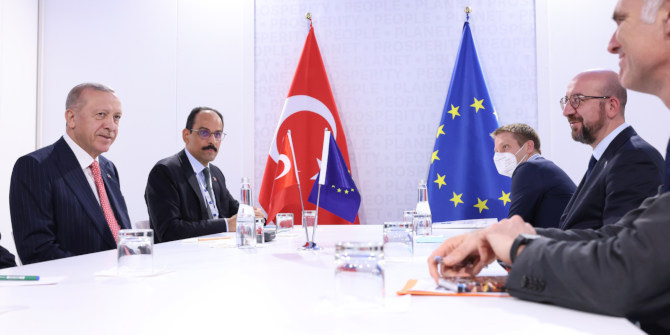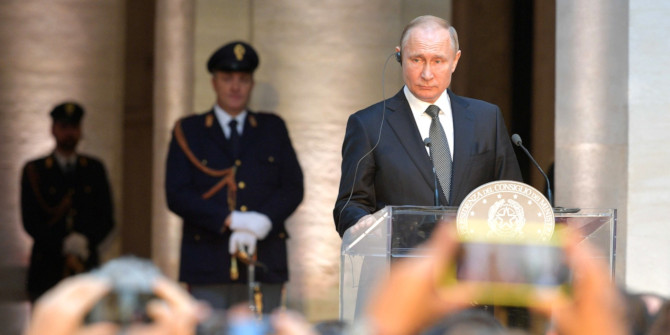 The protests which ultimately led to the fall of Viktor Yanukovych’s government in Ukraine in 2014 began after the country failed to sign a trade agreement with the EU. But could trade policy also offer a way out of the crisis? Robert Basedow writes that while talk of establishing a free trade area ‘from Lisbon to Vladivostok’ is unrealistic in the short-term, the EU should nevertheless pursue a strategy focused on evenly reducing trade barriers in the Eurasian space.
The protests which ultimately led to the fall of Viktor Yanukovych’s government in Ukraine in 2014 began after the country failed to sign a trade agreement with the EU. But could trade policy also offer a way out of the crisis? Robert Basedow writes that while talk of establishing a free trade area ‘from Lisbon to Vladivostok’ is unrealistic in the short-term, the EU should nevertheless pursue a strategy focused on evenly reducing trade barriers in the Eurasian space.
Trade policy played a key role in the outbreak of the Ukraine crisis. In November 2013, the Yanukovych government – under manifest pressure from Moscow – decided not to sign the Deep and Comprehensive Free Trade Agreement (DCFTA) with the EU. Instead it announced plans to intensify economic cooperation with Russia. This decision led to the Maidan protests and ultimately the fall of the Yanukovych government in February 2014. The new Ukrainian leadership signed the DCFTA with the EU in June 2014 but the EU and Ukraine decided to postpone its entry into force in order to keep the door open for peace talks with Russia. Russia’s persistent opposition against the DCFTA remains today one of the key drivers of the Ukraine crisis.
What are Russia’s concerns regarding the EU-Ukraine DCFTA?
On a general level, Russia worries that the DCFTA will pull Ukraine into the western European economic and political system and thereby erode Russia’s influence on Ukraine. It reflects Russia’s vision of international relations as a zero-sum game in which either Russia or the West can win. This general concern finds expression in a number of more technical critiques of the DCFTA. Russia argues, for instance, that under the DCFTA Ukraine will have to adapt to western technical standards and norms, which should arguably increase hurdles for Ukraine-Russia trade. The claim is misleading: Ukraine commits to recognising western standards but the DCFTA does not rule out the continued use of former Soviet and Russian standards and norms in Ukraine.
What is more, Russia argues that Ukraine will re-export customs-free European products into Russia and thereby hurt its economy. Ukraine, Russia and other post-Soviet countries concluded in 2012 the so-called CISFTA, which allows for free trade in goods. Russia’s claim is again incorrect. The CISFTA and the DCFTA both contain Rules of Origin (RoO), which specify when a product must be considered of Ukrainian, European or Russian origin and may therefore benefit from preferential market access under the respective agreement. Rules of Origin are widely used in international trade, as most countries are party to several free trade agreements and face the same challenge. Second, the signatories of the CISFTA – including Russia – have not dismantled customs and other trade barriers as agreed. Free trade remains an illusion, which implies that Ukraine customs-free re-exporting European products into Russia is not a credible scenario.

While Russia’s concerns may be unfounded, they underline the role of trade policy in triggering and prolonging the Ukraine crisis. Hence, trade policy also has a role to play in resolving the crisis. Rather than fragmenting the Eurasian space in economic blocks, western policy-makers must aim at evenly reducing trade barriers between the EU, Russia and other post-Soviet states so as to advance economic and political integration.
Such a strategy should yield the desired economic effects and sidestep the current geopolitical tensions. In 2010, Vladimir Putin proposed in this spirit an ambitious project to establish a free trade area reaching from Lisbon to Vladivostok. Earlier this year, the German government revived the idea as a potential roadmap for enhancing EU-Russia relations and ending the Ukraine crisis.
The idea is economically tempting from a European point of view, but hardly realisable in the short run. Earlier attempts to liberalise EU-Russia trade have failed due to a lack of sincere interest by Russia in such projects. Russia is unlikely to benefit from trade liberalisation in the short and medium term: 82 per cent of the country’s exports are energy commodities and hardly subject to trade barriers.
Other Russian sectors lack competitiveness and would go through a phase of painful restructuring when exposed to international competition. The current economic crisis and western economic sanctions make it even less likely that Russia will bite the bullet and open up its economy. So negotiations on a Eurasian free trade area may constitute a long-term vision, but in the short run, the EU will have to resort to other trade policy strategies in order to settle the Ukraine crisis and enhance East-West relations.
How trade policy can help settle the Ukraine crisis
Three mid-term strategies seem workable. First, the EU must focus on strengthening the role of the WTO in the Eurasian space. In comparison to other world regions, the WTO plays a limited role in the Eurasian space. On the one hand, several countries are not yet WTO members, hence, they are not bound by WTO law and not subject to the WTO’s dispute settlement mechanism. On the other hand, those post-Soviet countries which are WTO members are known to unreliably implement WTO law.
It is crucial to embed trade in the Eurasian region into the multilateral rules and dispute settlement mechanisms of the WTO in order to depoliticise trade and to fully integrate the region into the world economy. The EU should therefore push those countries which are not yet WTO members, such as Belarus and Kazakhstan, to speed up their accession process. It should also ensure through political dialogues and technical assistance that WTO members in the region respect WTO law.
Second, the EU should encourage post-soviet states like Ukraine, Moldova and Georgia to pursue a double integration strategy. They should unilaterally reduce trade barriers and seek to modernise the CISFTA with Russia or negotiate modern free trade agreements with the Eurasian Economic Union (EEU). The EEU was established in 2015 as a customs union and emerging single market encompassing Russia, Belarus, Kazakhstan, Kirgizstan and Armenia.
Such a strategy would generally lower trade barriers in the Eurasian space, contribute to the modernisation of these economies, preserve historically grown production chains and reduce geopolitical tensions with Russia. In the 1990s, Chile faced similar pressures to join the regional trading block Mercosur and managed through unilateral liberalisation and a multipolar free trade agreement strategy to grow and to establish good relations with its neighbours and beyond.
Third, the EU should focus on the newly founded EEU – rather than Russia – as its main partner in trade policy. Russia’s trade policy is notoriously politicised and disrespects international legal commitments. The EEU may constitute a more reliable partner. The EEU is modelled after the EU. It builds on an elaborate system of supranational institutions and law, which governs its joint foreign economic policy and its emerging single market. Each EEU member has one vote in the ministerial council and decisions are made by qualified majority.
Kazakhstan, Belarus, Kyrgyzstan and Armenia are likely to use the EEU to counterbalance Russia’s hegemonic foreign policy. Taking into consideration that the EEU’s High Council of the heads of state has extensive powers and may revoke decisions of the ministerial council, the supranational Eurasian Economic Commission and Court, it still remains to be seen how effective and rules-based the EEU will actually be in practice. The EEU, nevertheless, offers the rare opportunity to depoliticise Russian trade policy and to economically unlock the Eurasian space.
Trade policy played a key role in the outbreak of the Ukraine crisis and is likely to play a role in its settlement. Western policy-makers should focus on evenly reducing trade barriers in the Eurasian space in order to avoid fragmenting the region. A Eurasian free trade area as proposed by Vladimir Putin and more recently the German government may be a long-term vision, but it is unlikely to see the light of day in the near future. The EU should therefore seek to strengthen the role of the WTO, encourage post-soviet states to engage in double integration vis-à-vis the West and the EEU and finally focus on the Eurasian Economic Union as its primary partner for trade policy in the region.
Please read our comments policy before commenting.
Note: This article gives the views of the author, and not the position of EUROPP – European Politics and Policy, nor of the London School of Economics.
Shortened URL for this post: http://bit.ly/1GvMqWy
_________________________________
 Robert Basedow – LSE
Robert Basedow – LSE
Robert Basedow is a PhD candidate in the International Relations Department at the London School of Economics. His research focuses on the EU’s new international investment policy.





